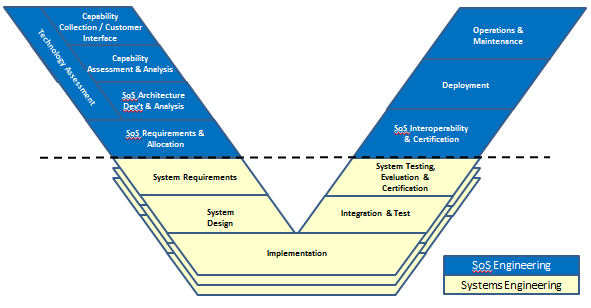Introduction
This article provides introduction and overview of several publications from the academic and professional community that provide details on the governance and life cycle models required for effective SoS management. The goal of this article is to establish for the reader awareness of these publications and there contents as a significant source of information on system of systems engineering and integration.
Defining a System of Systems Engineering and Integration Approach to Addressing Navy’s Information Dominance Technical Authority
A Criteria-Based Framework for Establishing System of Systems Governance
The System of Systems Engineering and Integration VEE Model
Citation Information
Vaneman, Warren K. 2016. The System of Systems Engineering and Integration Vee Model. Proceedings of the10th Annual IEEE Systems Conference, Orlando, FL, April 18-21.
Vaneman, Warren K., and Richard Budka. 2013. Defining a System of Systems Engineering and Integration Approach to Address the Navy's Information Technology Technical Authority. Proceedings of the INCOSE International Symposium, June 2013, Philadelphia, PA.
"Vaneman, Warren K. and Rodger D. Jaskot. A Criteria-Based Framework for Establishing System of Systems Governance. Academic, Unpublished Work."
Defining a System of Systems Engineering and Integration Approach to Addressing Navy’s Information Dominance Technical Authority first introduced the term systems of systems engineering and integration (SoSEI) and define it as the planning, analyzing and integrating of constituent systems into a capability greater than the sum of its parts (Vaneman and Budka 2013). Vaneman and Budka (2013) speak to the need for a continual planning and integration function that synchronizes the changing needs of the SoS users, programs under development and emergent behaviors of the SoS. This document establishes a methodology for the continual planning, integration and assessment functions required for sustained SoS performance.
A Criteria-Based Framework for Establishing System of Systems Governance expands on the idea of a holistic SoSEI approach by describing the governance models required for effective SoS Management (Vaneman and Jaskot 2013). Vaneman and Jaskot (2013) start by aggregating the elements and best practices associated with sound governance models found in industry and government publications into a set of SoS Governance Principles. These principles create a set of criteria that define the individual governance models tailorable to the type of SoS being governed (Vaneman and Jaskot 2013).
The System of Systems Engineering and Integration VEE Model paper further defines the SoSEI approach presented in earlier works by defining an end-to-end life cycle for the continuous assessment of SoS performance and guiding change to the SoS through architectures and standards implemented within the sub-systems of the SoS (Vaneman 2016). The SoSEI Vee (Figure 2) expands the typical SE Vee to show the connection between the overarching SoS engineering and integration activities and the activities executed to design and develop the individual constituent systems of the SoS.

Source: Vaneman (2016)
The bottom half of the Vee represents the engineering and development activities associated with a typical systems-development program. The yellow SE Vee appears in numerous SE publications to show how a SE decomposes a problem from the top left of the Vee down through a design phase, and then recomposes the design up the right side to achieve the delivery of a complete solution. Multiple yellow Vees are shown to represent the multiple systems and their independent development life cycles as part of the larger SoS (Vaneman 2016).
The top half of the Vee represents the integrated set of activities required to manage an SoS as an enduring activity. As with a standard SE project, the SoSEI Vee starts at the top left and follows a similar but much more broader requirements and architecting sequence to define, assess and steer the evolution of the SoS and its constituent systems. The middle of the SoSEI Vee shows the management and governance function missing from many SoS approaches. The top right side of the Vee is again similar to a SE project but also deals with the continuous configuration management and end-to-end testing and validation functions for the SoS (Vaneman 2016).
The SoSEI Vee is a systems engineering life cycle that integrates the engineering and management activities for the SoS with the engineering and management activities of the constituent systems within the SoS.